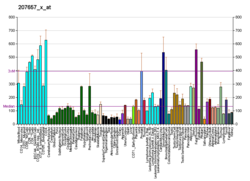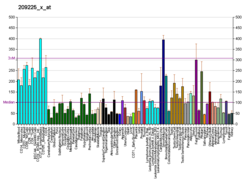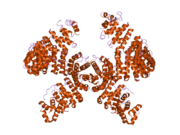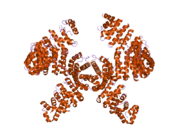Protein-coding gene in the species Homo sapiens
| TNPO1 | |||||||||||||||||||||||||||||||||||||||||||||||||||
|---|---|---|---|---|---|---|---|---|---|---|---|---|---|---|---|---|---|---|---|---|---|---|---|---|---|---|---|---|---|---|---|---|---|---|---|---|---|---|---|---|---|---|---|---|---|---|---|---|---|---|---|
 | |||||||||||||||||||||||||||||||||||||||||||||||||||
| |||||||||||||||||||||||||||||||||||||||||||||||||||
| Identifiers | |||||||||||||||||||||||||||||||||||||||||||||||||||
| Aliases | TNPO1, IPO2, KPNB2, MIP, MIP1, TRN, Transportin 1 | ||||||||||||||||||||||||||||||||||||||||||||||||||
| External IDs | OMIM: 602901; MGI: 2681523; HomoloGene: 5358; GeneCards: TNPO1; OMA:TNPO1 - orthologs | ||||||||||||||||||||||||||||||||||||||||||||||||||
| |||||||||||||||||||||||||||||||||||||||||||||||||||
| |||||||||||||||||||||||||||||||||||||||||||||||||||
| |||||||||||||||||||||||||||||||||||||||||||||||||||
| |||||||||||||||||||||||||||||||||||||||||||||||||||
| |||||||||||||||||||||||||||||||||||||||||||||||||||
| Wikidata | |||||||||||||||||||||||||||||||||||||||||||||||||||
| |||||||||||||||||||||||||||||||||||||||||||||||||||
Transportin-1 (or Importin-β 2) is a protein that in humans is encoded by the TNPO1 gene.
Function
This protein is a karyopherin which interacts with nuclear localization sequence to target nuclear proteins to the nucleus. The classical karyopherin receptor complex, such as the complex that uses Importin-β1 (encoded by gene KPNB1), is a heterodimer of an alpha subunit which recognizes the nuclear localization signal and a beta subunit which docks the complex at nucleoporins. However, Transportin-1 can directly bind to the cargo proteins and may not need importin alpha subunit to do it.
Transportin-1 is thought to use the same principal mechanism to carry out nuclear transport as other Importins. It mediates docking to the nuclear pore complex through binding to nucleoporin and is subsequently translocated through the pore by an energy requiring mechanism. Then, in the nucleus Ran binds to Transportin-1, it dissociates from cargo, and Transportin-1 is re-exported from the nucleus to the cytoplasm where GTP hydrolysis releases Ran. Then Transportin-1 is free to bind new cargo.
In addition, Transportin-1 is implicated in helping protein transport into primary cilium. The function of Transportin-1 in this case is thought to be similar to carrying proteins into the nucleus through a nuclear pore. Transportin-1 binds cargo and then is helping this cargo to pass through a pore at the base of the cilium. Ran and nucleoporins are also implicated in this mechanism.
Alternate splicing of this gene results in two transcript variants encoding different proteins.
Targets
Transportin 1 (TRN1) is part of the non-classical nuclear import pathway. In conjunction with the RanGTP hydrolysis cascade TRN1 acts to import a selection of proteins into the nucleus of cells. These targets typically contain a PY-motif otherwise known as a M9 nuclear localisation signal. Well described examples include hnRNP A1.
The type of cargo proteins that Transportin 1 can carry into the nucleus include RNA-binding proteins (such as hnRNP A1 and hnRNP F) and also ribosomal proteins.
Clinical significance
TRN1 has been implicated in the pathogenesis of two neurodegenerative diseases namely amyotrophic lateral sclerosis and frontotemporal dementia.
Interactions
Transportin 1 has been shown to interact with:
- RGPD5 and
- Ran (biology).
References
- ^ GRCh38: Ensembl release 89: ENSG00000083312 – Ensembl, May 2017
- ^ GRCm38: Ensembl release 89: ENSMUSG00000009470 – Ensembl, May 2017
- "Human PubMed Reference:". National Center for Biotechnology Information, U.S. National Library of Medicine.
- "Mouse PubMed Reference:". National Center for Biotechnology Information, U.S. National Library of Medicine.
- Pollard VW, Michael WM, Nakielny S, Siomi MC, Wang F, Dreyfuss G (Dec 1996). "A novel receptor-mediated nuclear protein import pathway". Cell. 86 (6): 985–94. doi:10.1016/S0092-8674(00)80173-7. PMID 8808633. S2CID 15666255.
- Bonifaci N, Moroianu J, Radu A, Blobel G (Jun 1997). "Karyopherin beta2 mediates nuclear import of a mRNA binding protein". Proc. Natl. Acad. Sci. U.S.A. 94 (10): 5055–60. Bibcode:1997PNAS...94.5055B. doi:10.1073/pnas.94.10.5055. PMC 24630. PMID 9144189.
- ^ "Entrez Gene: TNPO1 transportin 1".
- R.A. Fridell (1997). Nuclear import of hnRNP A1 is mediated by a novel cellular cofactor related to karyopherin-beta. Journal of Cell Science 1997 110: 1325-1331;
- Toby W. Hurd (2011). Localization of retinitis pigmentosa 2 to cilia is regulated by Importin β2. J Cell Sci 2011 124: 718-726; doi: 10.1242/jcs.070839
- Kee HL (2012). A size-exclusion permeability barrier and nucleoporins characterize a ciliary pore complex that regulates transport into cilia.. Nat. Cell Biol. 2012 Mar 4;14(4):431-7. doi: 10.1038/ncb2450.
- Dormann D, Rodde R, Edbauer D, Bentmann E, Fischer I, Hruscha A, Than ME, Mackenzie IR, Capell A, Schmid B, Neumann M, Haass C (August 2010). "ALS-associated fused in sarcoma (FUS) mutations disrupt Transportin-mediated nuclear import". EMBO J. 29 (16): 2841–57. doi:10.1038/emboj.2010.143. PMC 2924641. PMID 20606625.
- Anne-Christine Ström (2001). Importin-beta-like nuclear transport receptors. Genome Biol. 2001; 2(6): reviews3008.1–reviews3008.9.
- Brelstaff J, Lashley T, Holton JL, Lees AJ, Rossor MN, Bandopadhyay R, Revesz T (November 2011). "Transportin1: a marker of FTLD-FUS". Acta Neuropathol. 122 (5): 591–600. doi:10.1007/s00401-011-0863-6. PMID 21847626. S2CID 5913873.
- Cai Y, Miao SY, Wang LF (October 2001). "". Zhongguo Yi Xue Ke Xue Yuan Xue Bao (in Chinese). 23 (5): 462–6. PMID 12905863.
- Chook YM, Blobel G (May 1999). "Structure of the nuclear transport complex karyopherin-beta2-Ran x GppNHp". Nature. 399 (6733): 230–7. Bibcode:1999Natur.399..230C. doi:10.1038/20375. PMID 10353245. S2CID 4413233.
- Shamsher MK, Ploski J, Radu A (October 2002). "Karyopherin beta 2B participates in mRNA export from the nucleus". Proc. Natl. Acad. Sci. U.S.A. 99 (22): 14195–9. Bibcode:2002PNAS...9914195S. doi:10.1073/pnas.212518199. PMC 137860. PMID 12384575.
Further reading
- Bukrinsky MI, Haffar OK (1997). "HIV-1 nuclear import: in search of a leader". Front. Biosci. 2 (4): d578-87. doi:10.2741/A213. PMID 9366553.
- Bukrinsky MI, Haffar OK (1998). "HIV-1 nuclear import: matrix protein is back on center stage, this time together with Vpr". Mol. Med. 4 (3): 138–43. doi:10.1007/BF03401911. PMC 2230352. PMID 9562972.
- Bukrinsky MI, Sharova N, Dempsey MP, Stanwick TL, Bukrinskaya AG, Haggerty S, Stevenson M (1992). "Active nuclear import of human immunodeficiency virus type 1 preintegration complexes". Proc. Natl. Acad. Sci. U.S.A. 89 (14): 6580–4. Bibcode:1992PNAS...89.6580B. doi:10.1073/pnas.89.14.6580. PMC 49545. PMID 1631159.
- Moroianu J, Hijikata M, Blobel G, Radu A (1995). "Mammalian karyopherin alpha 1 beta and alpha 2 beta heterodimers: alpha 1 or alpha 2 subunit binds nuclear localization signal and beta subunit interacts with peptide repeat-containing nucleoporins". Proc. Natl. Acad. Sci. U.S.A. 92 (14): 6532–6. Bibcode:1995PNAS...92.6532M. doi:10.1073/pnas.92.14.6532. PMC 41552. PMID 7604027.
- Bukrinsky MI, Haggerty S, Dempsey MP, Sharova N, Adzhubel A, Spitz L, Lewis P, Goldfarb D, Emerman M, Stevenson M (1993). "A nuclear localization signal within HIV-1 matrix protein that governs infection of non-dividing cells". Nature. 365 (6447): 666–9. Bibcode:1993Natur.365..666B. doi:10.1038/365666a0. PMC 9524217. PMID 8105392. S2CID 25678.
- Michael WM, Choi M, Dreyfuss G (1995). "A nuclear export signal in hnRNP A1: a signal-mediated, temperature-dependent nuclear protein export pathway". Cell. 83 (3): 415–22. doi:10.1016/0092-8674(95)90119-1. PMID 8521471. S2CID 615927.
- Nakielny S, Siomi MC, Siomi H, Michael WM, Pollard V, Dreyfuss G (1996). "Transportin: nuclear transport receptor of a novel nuclear protein import pathway". Exp. Cell Res. 229 (2): 261–6. doi:10.1006/excr.1996.0369. PMID 8986607.
- Fridell RA, Truant R, Thorne L, Benson RE, Cullen BR (1997). "Nuclear import of hnRNP A1 is mediated by a novel cellular cofactor related to karyopherin-beta". J. Cell Sci. 110 (11): 1325–31. doi:10.1242/jcs.110.11.1325. PMID 9202393.
- Gallay P, Hope T, Chin D, Trono D (1997). "HIV-1 infection of nondividing cells through the recognition of integrase by the importin/karyopherin pathway". Proc. Natl. Acad. Sci. U.S.A. 94 (18): 9825–30. Bibcode:1997PNAS...94.9825G. doi:10.1073/pnas.94.18.9825. PMC 23276. PMID 9275210.
- Siomi MC, Eder PS, Kataoka N, Wan L, Liu Q, Dreyfuss G (1997). "Transportin-mediated nuclear import of heterogeneous nuclear RNP proteins". J. Cell Biol. 138 (6): 1181–92. doi:10.1083/jcb.138.6.1181. PMC 2132560. PMID 9298975.
- Henderson BR, Percipalle P (1997). "Interactions between HIV Rev and nuclear import and export factors: the Rev nuclear localisation signal mediates specific binding to human importin-beta". J. Mol. Biol. 274 (5): 693–707. doi:10.1006/jmbi.1997.1420. PMID 9405152.
- Efthymiadis A, Briggs LJ, Jans DA (1998). "The HIV-1 Tat nuclear localization sequence confers novel nuclear import properties". J. Biol. Chem. 273 (3): 1623–8. doi:10.1074/jbc.273.3.1623. PMID 9430704.
- Vodicka MA, Koepp DM, Silver PA, Emerman M (1998). "HIV-1 Vpr interacts with the nuclear transport pathway to promote macrophage infection". Genes Dev. 12 (2): 175–85. doi:10.1101/gad.12.2.175. PMC 316441. PMID 9436978.
- Popov S, Rexach M, Zybarth G, Reiling N, Lee MA, Ratner L, Lane CM, Moore MS, Blobel G, Bukrinsky M (1998). "Viral protein R regulates nuclear import of the HIV-1 pre-integration complex". EMBO J. 17 (4): 909–17. doi:10.1093/emboj/17.4.909. PMC 1170440. PMID 9463369.
- Popov S, Rexach M, Ratner L, Blobel G, Bukrinsky M (1998). "Viral protein R regulates docking of the HIV-1 preintegration complex to the nuclear pore complex". J. Biol. Chem. 273 (21): 13347–52. doi:10.1074/jbc.273.21.13347. PMID 9582382.
- Fouchier RA, Meyer BE, Simon JH, Fischer U, Albright AV, González-Scarano F, Malim MH (1998). "Interaction of the human immunodeficiency virus type 1 Vpr protein with the nuclear pore complex". J. Virol. 72 (7): 6004–13. doi:10.1128/JVI.72.7.6004-6013.1998. PMC 110405. PMID 9621063.
| PDB gallery | |
|---|---|









